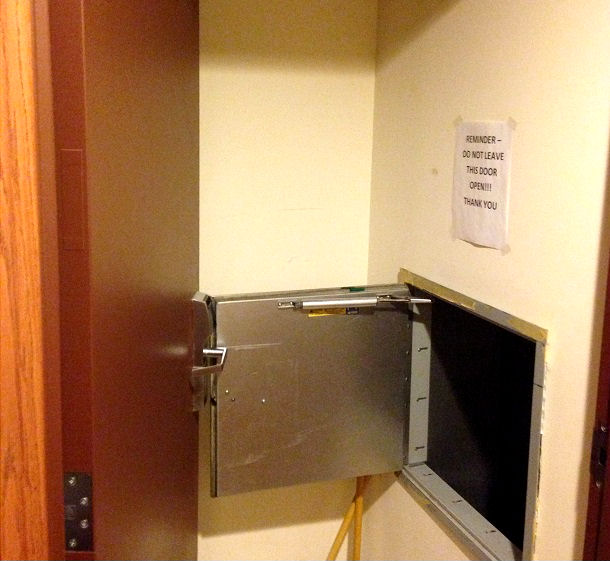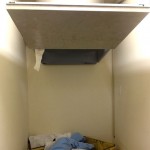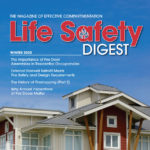Almost 10 years ago, I received the photos below from Chad Jenkins of the National Locksmith Institute. This was not the first (nor the last) time that I have seen a conflict between a chute door and a swinging fire door that provides a convenient way to hold the doors open. Unfortunately, I have also seen reports of fires where the trash chute or laundry chute contributed to the spread of smoke and loss of life. This has now been addressed in the International Building Code (IBC).
Chad wrote:
“This hotel has a laundry chute that has self-closing devices on the chute doors. They are secured behind a fire rated self-closing storage room door (label has been painted over). The arrangement of the door swing allows employees to use one door to prop open the other creating a chimney throughout the building. You will also see a sign above the rated laundry chute door that reminds people to ensure the door closes. The manager of the hotel did say they would send out a memo to their staff to address this issue.”
Here’s the condition on the 2nd, 3rd, and 4th floors:
And the first floor:
The requirements for chutes are found in Chapter 7 of the IBC, in the section called Shaft Enclosures. In the 2018 and 2021 editions of the code, Section 713.13 covers waste (including recycling) and linen chutes, as well as incinerator rooms. The access openings to these chutes must be enclosed by 1-hour fire barriers and/or fire-resistance-rated horizontal assemblies. Openings into the access room are required to have opening protectives with a rating of at least 45 minutes, with fire doors that are self-closing or automatic-closing upon smoke detection. The door to the chute is also required to be fire rated – either 60 minutes or 90 minutes depending on the height of the shaft.
Here is the new language regarding the door conflict: The room or compartment shall be configured to allow the access door to the room or compartment to close and latch with the access panel to the chute in any position. This prescriptive requirement will help to increase the likelihood that both the chute door and the room access door will be closed and latched if a fire occurs, providing the necessary protection to deter the spread of smoke between floors of the building.
You need to login or register to bookmark/favorite this content.











Interesting
Never saw the door on door holding condition.
Normally a door stop
I guess someone saw it enough to get it added to the code!! Way to go.
I know! I love when I see something prescriptive in the codes or standards that attempts to solve a specific problem!
– Lori